This period of English football is best remembered for Herbert Chapman leading Huddersfield Town to successive titles before leaving them for Arsenal and immediately turning the north Londoners around from a side battling relegation to one challenging for the title. In his first season in charge of the Gunners, he steered them to second place - just five points behind his previous club, who had become the first side to win the league three times in a row. By the time of his death in 1934, he had repeated his achievements in West Yorkshire with Arsenal and set them well on their way to emulating the Terriers by winning a consecutive hattrick of titles for themselves. Legend also has it that Herbert Chapman had a hand in designing Arsenal's kits - giving their plain red jerseys the now iconic white sleeves.
Chapman's namesake at United did not fare quite so well, although he did eventually succeed in returning the club to the First Division and similarly had a big influence in their kit design.
For home games in the 1922/23 season, United turned out not in their now familiar red jerseys, but in white ones with a red "V" (or more properly "diamonds", as there was another V on the back of the shirts joined at the shoulder seams). These shirts were very similar to those worn by United in the 1909 FA Cup Final victory, albeit with a larger, thicker diamond and a button collar rather than a lace one.
Perhaps the reason for this change was a belief that a design worn back in the glory days would inspire a renaissance at United. More likely however, is that the change was down to the new manager's previous club. He had joined from Airdrieonians, who had been wearing identical kits for a decade (in fact, Airdieonian's nickname was The Diamonds, due to the design of their kit).
When Chapman took over at Airdrie, they had been wearing red and white stripes or hoops, so it seems he may have been instrumental in introducing the new design there, too. Perhaps the jerseys had made the journey south along with John Chapman when he took up the post at United. We will almost certainly never know for sure, but the white shirts would remain United's first choice for the next five years.
Chapman's namesake at United did not fare quite so well, although he did eventually succeed in returning the club to the First Division and similarly had a big influence in their kit design.
For home games in the 1922/23 season, United turned out not in their now familiar red jerseys, but in white ones with a red "V" (or more properly "diamonds", as there was another V on the back of the shirts joined at the shoulder seams). These shirts were very similar to those worn by United in the 1909 FA Cup Final victory, albeit with a larger, thicker diamond and a button collar rather than a lace one.
Perhaps the reason for this change was a belief that a design worn back in the glory days would inspire a renaissance at United. More likely however, is that the change was down to the new manager's previous club. He had joined from Airdrieonians, who had been wearing identical kits for a decade (in fact, Airdieonian's nickname was The Diamonds, due to the design of their kit).
When Chapman took over at Airdrie, they had been wearing red and white stripes or hoops, so it seems he may have been instrumental in introducing the new design there, too. Perhaps the jerseys had made the journey south along with John Chapman when he took up the post at United. We will almost certainly never know for sure, but the white shirts would remain United's first choice for the next five years.
In the top left of the picture is Frank Barson, who was making his United debut. He had been signed for £5,000 from Aston Villa, with whom he had won the FA Cup in 1920, and he came with a notorious reputation having been sent off and suspended on numerous occasions in an era where receiving a red card was a rarity. In his contract was written an agreement to make Barson the landlord of a pub in Manchester if United were to be promoted (presumably due to the club's continued patronage by JH Davies). He would go on captain the club during his six years at Old Trafford before being transferred to Watford in 1928.
United's optimism for the 1922/23 season wasn't quite matched by their performances as they found the second division a little tougher than they had expected. They had enjoyed some decent results, such as a 6-1 win against league leaders and eventual champions Notts County, but they had drawn far too many games and finished three points shy of promotion in fourth place. Their cup run in now typical style had ended in the second round, beaten 4-0 by Spurs at White Hart Lane. Worryingly, it had been a decade since United had progressed any further in the competition.
United's dismal FA Cup record continued in the 1923/24 season when the two Chapmans met at Old Trafford in front of a crowd of 67,000 supporters. Huddersfield, who had finished third in the league the previous season proved too much for United, and won the game easily by three goals to nil.
The Red's league form slumped that season and they finished the season in a lowly 14th place having won only 13 matches - fewer than they had lost (15) or drawn (14). They hadn't finished in as low a position since the Newton Heath days.
The team are photographed before a practice match prior to the 1924/25 season. Half of the players appear to be wearing the old (now faded and stretched) home jerseys worn from 1920-22. Presumably they had been worn as change jerseys since the adoption of the white home shirts:
United's optimism for the 1922/23 season wasn't quite matched by their performances as they found the second division a little tougher than they had expected. They had enjoyed some decent results, such as a 6-1 win against league leaders and eventual champions Notts County, but they had drawn far too many games and finished three points shy of promotion in fourth place. Their cup run in now typical style had ended in the second round, beaten 4-0 by Spurs at White Hart Lane. Worryingly, it had been a decade since United had progressed any further in the competition.
United's dismal FA Cup record continued in the 1923/24 season when the two Chapmans met at Old Trafford in front of a crowd of 67,000 supporters. Huddersfield, who had finished third in the league the previous season proved too much for United, and won the game easily by three goals to nil.
The Red's league form slumped that season and they finished the season in a lowly 14th place having won only 13 matches - fewer than they had lost (15) or drawn (14). They hadn't finished in as low a position since the Newton Heath days.
The team are photographed before a practice match prior to the 1924/25 season. Half of the players appear to be wearing the old (now faded and stretched) home jerseys worn from 1920-22. Presumably they had been worn as change jerseys since the adoption of the white home shirts:
These photos are part of the extensive Leslie Millman collection that can be found at www.flickr.com/photos/manchesterunitedman1/ and are used with full permission.
The only change to these kits are the slightly different socks worn:
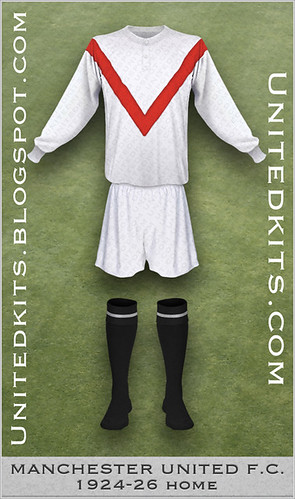

The only change to these kits are the slightly different socks worn:


The 1924/25 season saw United's cup run end at the earliest possible stage with a 2-0 loss at fellow second division side Sheffield Wednesday, but their league form was much improved. They strung together an impressive seven wins on the trot in Autumn to top the table and only lost two games in the rest of 1924. They had been deposed at the top by Leicester City, but promotion was virtually assured after a 4-0 home win against Port Vale in the penultimate match, leaving challengers Derby only a slim mathematical chance of taking United's place in the top flight the following season. United's players stayed on the pitch at the end of their fixture and the supporters waited inside Old Trafford with them, anxiously awaiting news of the other games. A huge cheer went up from fans and players alike when it was announced that Derby had been held to a draw at Coventry - United were back in the top flight after three years. Taking much of the credit were the defence who had conceded only 23 goals all season.
Legend has it that Frank Barson was given the keys to his pub shortly afterward, but his name would not remain over the door for long. Apparently, just minutes after it opened, he became so fed up of all the supporters pouring in off the streets to congratulate him, he handed the keys to a waiter, told him the place was his and left - never to return!
The following season saw United improve dramatically. In the league they finished in an impressive 9th place. They had accumulated the same amount of points as Liverpool and Aston Villa but had an inferior goal average. Had it not been for a run of five losses in April, the Reds may well have finished in the top four or five.
On September 12th the first Manchester derby to take place at Maine Road - where City had moved two years previously - was played. It was a 1-1 draw, which was a decent result considering the return fixture saw United hammered 6-1, the Reds biggest derby defeat to date.
Almost miraculously, United came close to ending their 17 years of cup disappointment by reaching the semi-final against their City rivals, having seen off Port Vale, Spurs, Sunderland and Fulham. Sadly, the blues comfortably beat United 3-0 at Bramhall Lane, but it was not to be their year either as they lost the final 1-0 to Bolton and were relegated a week later after losing to Newcastle 3-2 (having missed a penalty in a match they had only needed a draw from to guarantee survival). Apparently a local newspaper's headline the following day read "Bitter Experiences of Manchester City"...
During the FA Cup tie at Spurs, United were photographed wearing red change shirts with button collars like those on the home shirts:
Legend has it that Frank Barson was given the keys to his pub shortly afterward, but his name would not remain over the door for long. Apparently, just minutes after it opened, he became so fed up of all the supporters pouring in off the streets to congratulate him, he handed the keys to a waiter, told him the place was his and left - never to return!
The following season saw United improve dramatically. In the league they finished in an impressive 9th place. They had accumulated the same amount of points as Liverpool and Aston Villa but had an inferior goal average. Had it not been for a run of five losses in April, the Reds may well have finished in the top four or five.
On September 12th the first Manchester derby to take place at Maine Road - where City had moved two years previously - was played. It was a 1-1 draw, which was a decent result considering the return fixture saw United hammered 6-1, the Reds biggest derby defeat to date.
Almost miraculously, United came close to ending their 17 years of cup disappointment by reaching the semi-final against their City rivals, having seen off Port Vale, Spurs, Sunderland and Fulham. Sadly, the blues comfortably beat United 3-0 at Bramhall Lane, but it was not to be their year either as they lost the final 1-0 to Bolton and were relegated a week later after losing to Newcastle 3-2 (having missed a penalty in a match they had only needed a draw from to guarantee survival). Apparently a local newspaper's headline the following day read "Bitter Experiences of Manchester City"...
During the FA Cup tie at Spurs, United were photographed wearing red change shirts with button collars like those on the home shirts:
The 1926/27 season was less remarkable for United - at least as far as the events on the pitch. Once again United went out of the cup in the first round, albeit after taking their tie against Reading to a second replay at Villa Park, where they lost 2-1. They won only four fewer points in the league than they had the previous season, but it was enough to see them finish six places lower, in 15th position.
There were also slight changes to the kits as different socks were worn (photographs of this period are fairly difficult to get hold of, but these images have been made with reference to pictures on the computer screens at the United museum):
There were also slight changes to the kits as different socks were worn (photographs of this period are fairly difficult to get hold of, but these images have been made with reference to pictures on the computer screens at the United museum):
What the season was ultimately to be remembered for was the suspension of John Chapman. The FA had launched an investigation into the manager in September 1926 at Manchester's Grand Hotel. On October 7th, they announced that Chapman had been suspended "from taking part in football or football management during the present season for improper conduct in his position as Secretary-Manager of the Manchester United Football Club"". No further explanation was ever given and Chapman never returned to his position. Appointed in his place temporarily as player-manager, was Lal Hilditch, who had joined the club a decade earlier, during the war. His brief tenure lasted only until the beginning of April when Herbert Bamlett was given the job. Hilditch remains the club's only ever player-manager.
On the other side of Manchester, there was another one of those "typical City" moments, when on the last day of the season, the Maine Road side demolished Bradford 8-0 to almost certainly secure promotion ahead of Portsmouth, who had gone into the final round of fixtures with a minutely superior goal average and who City fans heard had been drawing 1-1 with Preston at half time. Just as celebrations were about to get underway in Moss Side, however, Pompey scored four second half goals to win 5-1 and pipped City to second place by the most minuscule margin: +0.006 goal average.
On the other side of Manchester, there was another one of those "typical City" moments, when on the last day of the season, the Maine Road side demolished Bradford 8-0 to almost certainly secure promotion ahead of Portsmouth, who had gone into the final round of fixtures with a minutely superior goal average and who City fans heard had been drawing 1-1 with Preston at half time. Just as celebrations were about to get underway in Moss Side, however, Pompey scored four second half goals to win 5-1 and pipped City to second place by the most minuscule margin: +0.006 goal average.


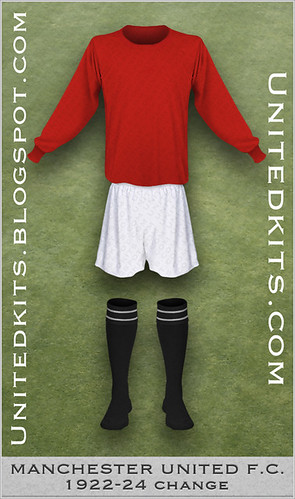
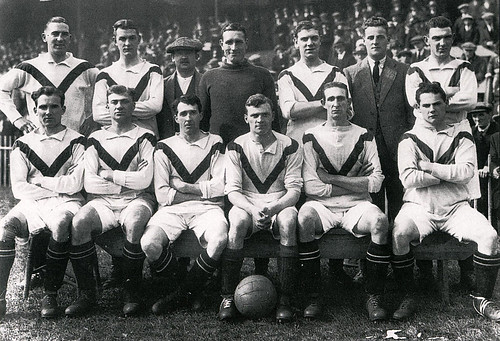

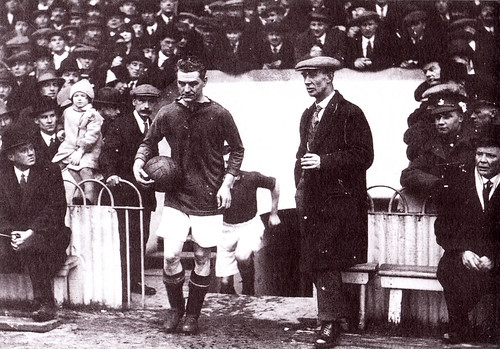
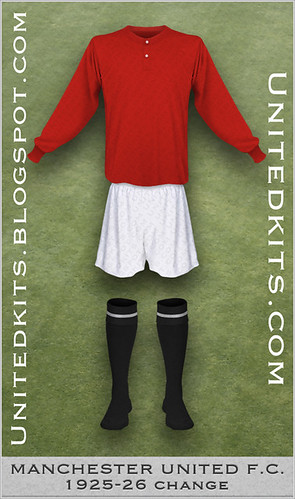
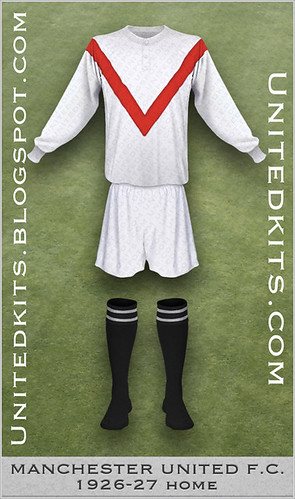
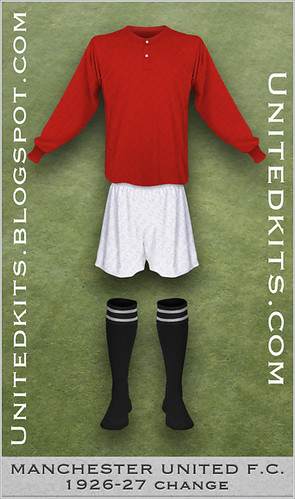
No comments:
Post a Comment